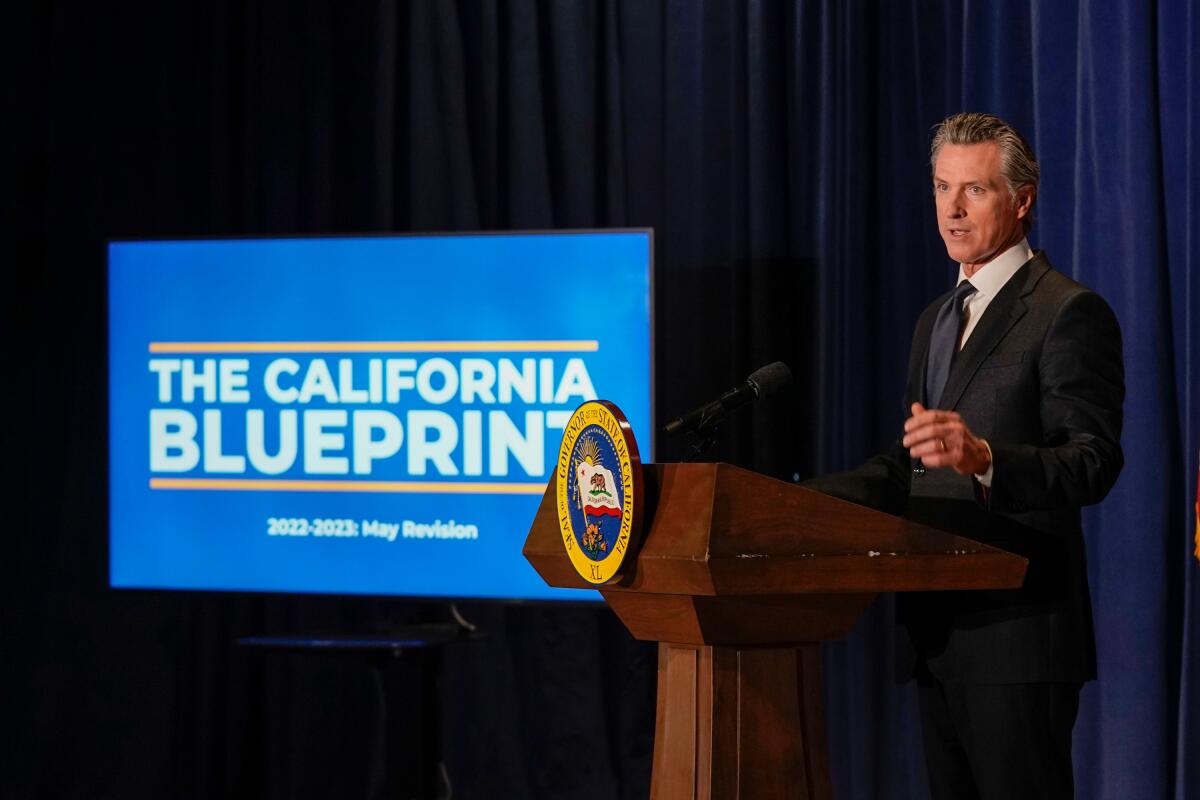Healthcare minimum wage expected to cost $4 billion in first year as California budget deficit looms

- Share via
SACRAMENTO — When Gov. Gavin Newsom signed a law that set a first-in-the-nation minimum wage for healthcare workers, three words in a bill analysis foretold potential concerns about its cost: “Fiscal impact unknown.”
Now, three weeks after Newsom signed SB 525 into law — giving medical employees at least $25 an hour, including support staff such as cleaners and security guards — his administration has an estimated price tag: $4 billion in the 2024-25 fiscal year alone.
Half of that will come directly from the state’s general fund, while the other half will be paid for by federal funds designated for providers of Medi-Cal, California’s Medicaid program, according to Newsom’s Department of Finance.
SB 525 is one of the most expensive laws California has seen in years and comes as the state faces a $14-billion budget deficit that could grow larger if revenue projections continue to fall short. It was one of several labor-backed measures the Democrat-controlled Legislature passed this year in what amounted to an unusually successful run for organized labor. What lawmakers didn’t fully account for, as they scrambled in the final days of the session to broker a deal between unions and hospitals to support the bill, was how much it would cost the state — or what might have to be cut to pay for it.
The costly legislation — promoted by unions as a way to curb the healthcare worker shortage and in turn improve patient care — was signed into law even as Newsom has warned about the state’s shaky financial future, vetoing dozens of bills last month in the name of cost savings. He wrote numerous veto messages saying lawmakers sent him bills that would cost a total of $19 billion that had not been accounted for in the budget.
“With our state facing continuing economic risk and revenue uncertainty, it is important to remain disciplined when considering bills with significant fiscal implications, such as this measure,” Newsom said repeatedly in those messages, rejecting some bills that had far lower cost projections than SB 525.
Among the many proposals that Newsom vetoed citing financial concerns was a bill that would have required that colleges pay for diagnostic assessments for students with disabilities, which would have cost the state $5 million annually, and a bill that would have expanded cash assistance for aged, blind and disabled immigrants, which would have cost the state at least $100 million.
Unknowns remain about implementation of the new wide-reaching minimum wage law, including the exact long-term costs, in part because of significant amendments made to the bill in the final days of the legislation session — a result of a rare truce between union and health-industry leaders deemed necessary to its passage.
Newsom officials declined to give The Times a cost estimate reflecting those amendments when the governor signed the bill last month. But the amendments were expected to significantly soften the immediate financial impact to the state and hospitals, since gradual wage schedules were introduced in lieu of an instantaneous increase for all.
Despite the unknowns, Democrats in the state Legislature — including some who were first hesitant about potential costs — were quick to pass the legislation after a deal was made between powerful interest groups.
The bill originally aimed to increase the minimum wage to $25 per hour for all healthcare employees starting Jan. 1. The opposition estimated that would have cost up to $8 billion annually.
While leaders of appropriations committees killed bills based on cost in September, rejecting measures that cost millions less than SB 525, the healthcare minimum wage bill cleared that key fiscal hurdle even as the Department of Finance opposed it, citing “significant economic impacts.”
It’s unclear whether other state programs will be cut to make room for the wage hikes, but expect state lawmakers to rush to write bills when the Legislature returns in January to try to address some financial concerns.
Unlike a law passed in 2016 that mandated a $15-per-hour minimum wage statewide, the healthcare worker bill does not currently include any mechanism that allows the state to delay wage hikes during economic downturns.
“This is an important law to ensure California has a robust healthcare workforce. We’re working with legislative leadership and stakeholders on accompanying legislation to account for state budget conditions and revenues,” Newsom spokesperson Alex Stack said on Friday when asked about cost concerns surrounding the bill.
The $4-billion estimate could change when the Legislative Analyst’s Office releases its annual fiscal outlook expected later this month. The cost is only expected to grow in the future, as more groups of workers become eligible for raises.
The latest estimated cost to the state reflects pay raises expected to go to half a million healthcare workers who provide services to Medi-Cal patients, plus 26,000 employees at state-owned facilities.
But the cost to the state could decrease if hospitals pay a bigger share of labor costs, said Tia Orr, executive director of SEIU California, who was involved in shaping the policy. She pointed to billions already set aside for Medi-Cal providers through revenue from a tax on managed healthcare organizations as one way to “help manage the impact of increased labor costs.”
“SEIU California has committed to working with the administration and the Legislature to ensure safeguards are in place to guarantee that this critical measure is taken in a way that preserves California’s fiscal health, just as we did when negotiating the last statewide minimum wage increase,” Orr said. “This is how you make progress — through flexibility and compromise in achieving shared goals.”
In a statement, David Simon, spokesperson for the California Hospital Assn., which ultimately supported the bill, called the plan that Newsom signed a “better, more measured” approach to raising wages than past efforts, which the organization worried would hurt rural hospitals already struggling financially and potentially pass costs onto patients.
Like Orr, Simon signaled more work to come.
“As far as any future work related to this issue, we are committed to working with the Legislature and the governor to advance the joint goals of SB 525: investing in our state’s healthcare workforce and preserving access to healthcare,” Simon said.
Under the law, workers at large healthcare facilities will earn $23 an hour starting in June, $24 an hour in 2025 and $25 in 2026. That applies to all staff, including launderers and hospital gift shop workers.
Employees at independent rural hospitals and facilities that serve high rates of Medicare and Medi-Cal patients will see $18 an hour next year and won’t reach $25 an hour until 2033. Other smaller workplaces are required to pay employees $21 an hour next year, reaching $25 an hour in 2028.
Newsom supporters see the legislation as bold national leadership amid labor unrest and worker strikes across industries, and as a more organized way to address local demands for $25 per hour already moving ahead in cities across California. His critics question if he approved it too soon without a concrete plan in order to gain political favor.
Labor unions have long held outsize power in the California Legislature, but their wins this year were remarkable. Their influence in state politics is undeniable: the Service Employees International Union pumped nearly $4 million into eight independent expenditures alone to get its Democrats of choice elected to the Legislature this year.
Michael Genest, founder of Capitol Matrix Consulting who served as a budget director for former Gov. Arnold Schwarzenegger, pointed to union power — and pressure — as one reason why Newsom may have moved too soon.
“This is no time to start adding really major costs to the state budget when it’s very possible we could go deeply in the wrong direction,” he said, noting the state’s economic uncertainty. “There’s always a reason to spend money, but some people care more about the reason than they do about what’s in the bank account.”
H.D. Palmer, Newsom’s Department of Finance spokesperson, has also acknowledged the state’s financial unknowns but was confident in the governor’s budgeting.
“The governor is required under the state Constitution to present a balanced budget by Jan. 10 of next year, which he will do,” he said. “There are any number of actions that can be done to balance a budget. Obviously the major thing right now is: Where are revenues going to go?”
More to Read
Sign up for Essential California
The most important California stories and recommendations in your inbox every morning.
You may occasionally receive promotional content from the Los Angeles Times.











